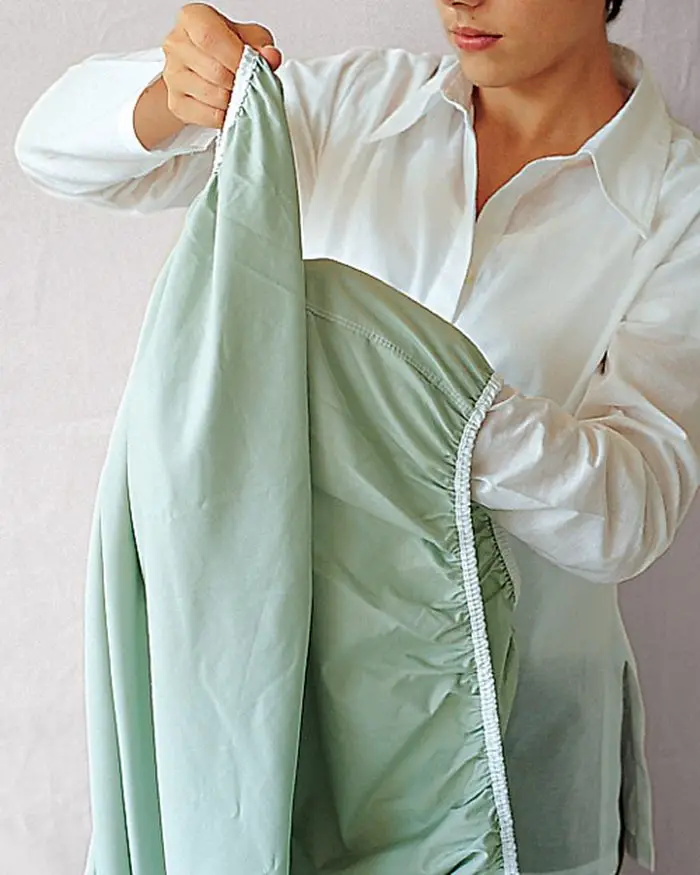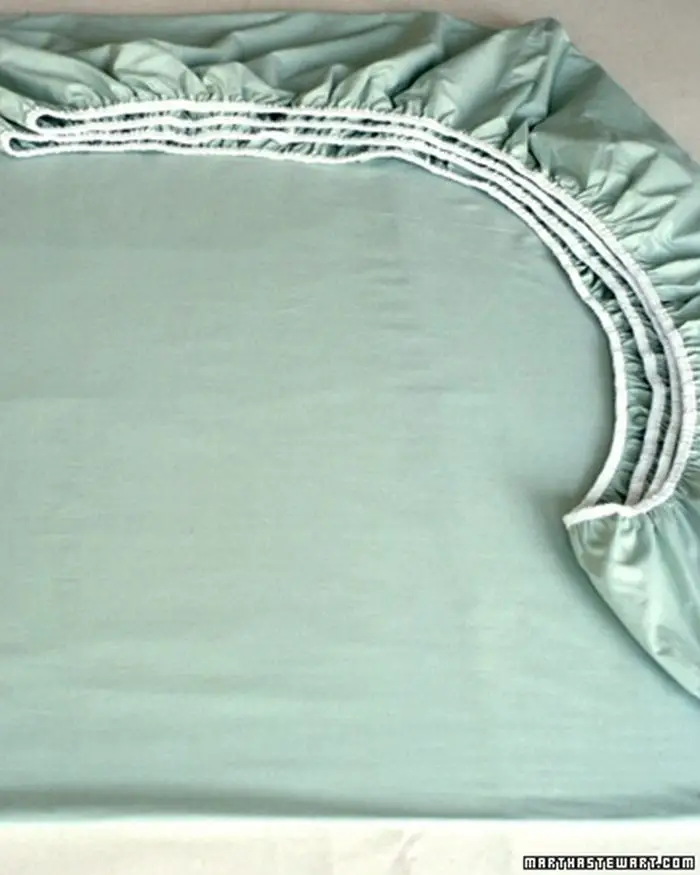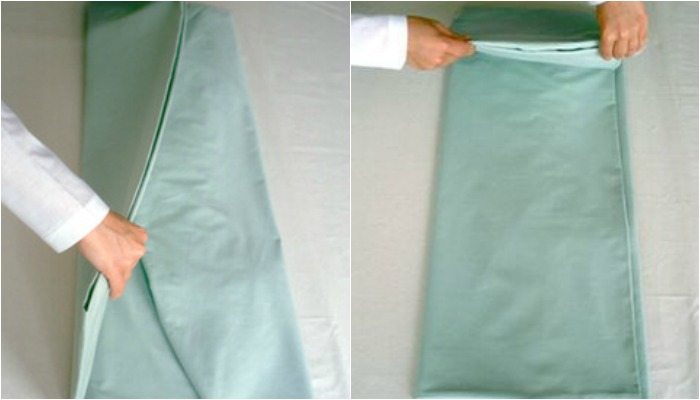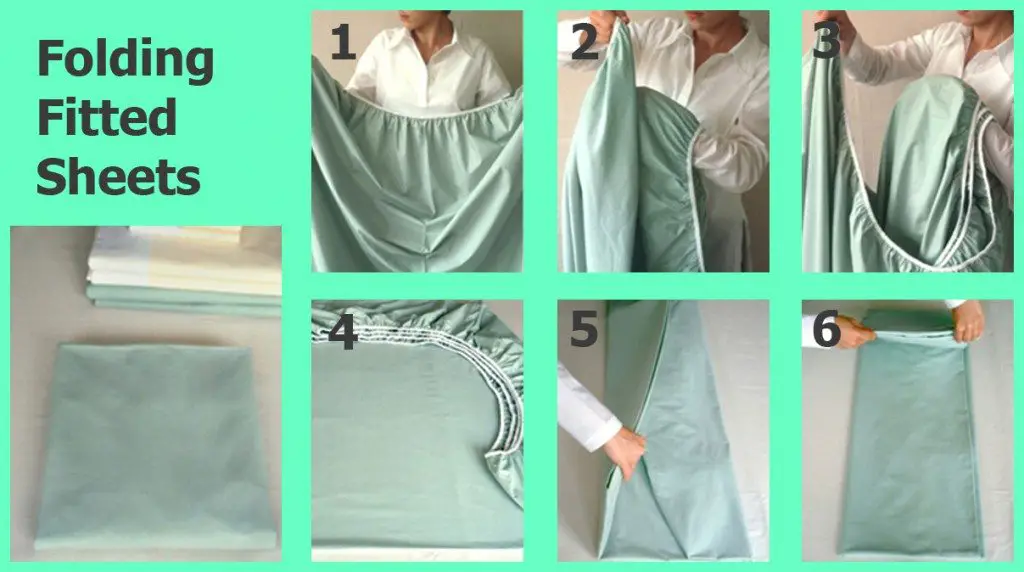Last Updated on August 20, 2024 by Team Ideas24
Are you struggling to keep your fitted sheets tidy and wrinkle-free? If so, you’re not alone.
Folding clothes can sometimes be very frustrating. It’s a tedious household chore, and I hate it, even more, when the clothes are being stubborn! Some are just difficult to fold so that it looks nice and clean. Then there’s the bedsheet. It’s already hard enough to deal with for its size, and its fitted corners add to the hassle.

They never fit into those bags without an honest struggle. Really, now, f
It’s definitely a challenge to fold a fitted sheet, but at least with that you can tuck in the corners and get a relatively tight fit. But with a little patience and perseverance, you can overcome the challenge of folding these sheets!
Good thing there’s one great person out there who shared his wisdom on how to do it right, and so we are passing it forward!
Here are some tips to make the task a little easier.
Click on any image to start the lightbox display. Use your Esc key to close the lightbox.![]()






Contents
Folding Fitted Sheets Professionally
Many people have trouble folding fitted sheets, but it’s actually not that difficult once you get the hang of it. Here’s a step-by-step guide to help you fold your fitted sheets like a pro.
1. To fold fitted sheets evenly, follow these tips. First, place your hands under the corners of the shorter side of the sheet. Make sure that the sheet is inside out. This will help prevent the sheet from bunching up and wearing out as quickly.
2. Bring one corner to meet the other and fold it to the adjacent corner.
3. Pick up the third corner and fold it to the corners you are holding. Then do the same with the last corner. Take note that the sheet should be inside out.
4. Now that all corners are together, lay the fitted sheet on a flat surface. Make sure the sheet and corners are folded nicely and cleanly.
5. Fold the sheet vertically, hiding the fitted corners.
6. Then fold it further until it is a rectangle that is as big as the other folded sheets that you have. This will give you a nice, clean fold.
Now you have a nice folded fitted sheet stored in your drawer. All set to be used the next time you need it!
You can keep them in the closet together with the regular sheets, nicely folded!
This is a great way to keep your sheets organized and tidy. By using this method, you can easily grab the sheet you need without having to search through a pile of messy sheets. Plus, it’ll help you keep your sheets in good condition for longer.
Thanks to Martha Stewart. You can watch the full step-by-step video here…
Choosing the Right Fitted Sheets for Your Bed
Choosing the right fitted sheets for your bed is not just about enhancing the aesthetic appeal of your bedroom but also about ensuring comfort and longevity. With a myriad of materials and styles available, it’s essential to make informed decisions to get the most out of your purchase.
Material Matters
When selecting fitted sheets, the fabric choice is crucial. Cotton, known for its breathability and durability, is a popular choice. For those seeking a luxurious feel, Egyptian or Pima cotton offers a softer, finer texture. If you’re looking for something wrinkle-resistant and durable, consider polyester blends. Each material offers different benefits, so consider your priorities, whether it’s comfort, ease of care, or longevity.
Size and Fit
Perfect fit depends on the right size fitting sheet. Knowing your mattress dimensions—including depth—is crucial since fitted sheets come in several pocket sizes. A fitted sheet that does not fit correctly will not stay in place and might cause a disturbing sleeping experience. Make sure the sheet’s depth covers the mattress and any toppers without slippability.
Thread Count and Weave
Often emphasized in sheet marketing, the thread count, that is, the number of threads spun into one square inch of fabric, Usually softer and more durable are higher thread count fitted sheets. Still, the weave also is rather important. A percale weave, for example, gives a crisp feel, while sateen produces a smoother, shinier finish. Determine your preferred feel and then select a thread count and weave that will satisfy your comfort requirements.
Keeping these elements in mind will help you choose fitted sheets that not only accentuate your bedroom décor but also help to promote peaceful night’s sleep. Recall that the comfort of your bedding and the general quality of your sleep can be much improved by the correct fitting sheets.
Common Mistakes to Avoid When Washing Fitted Sheets
Properly washing your fitted sheets is crucial to maintaining their quality, comfort, and longevity. However, many of us inadvertently make mistakes that can reduce the life of our sheets. By being aware of these common errors, you can ensure that your fitted sheets remain in top condition, providing comfort and enhancing the look of your bedroom for years to come.
Overloading the Washing Machine
One of the most common mistakes is overloading the washing machine. When you stuff the washer full, it doesn’t provide enough space for the sheets to move freely. This not only leads to uneven washing but can also cause excessive tugging and pulling on the fitted sheets, leading to faster wear and tear. To avoid this, wash your sheets separately or with only light garments like pillowcases or small towels.
Using Excessive Detergent
While it might seem like using more detergent would result in cleaner sheets, the opposite is true. Excessive detergent can leave a residue on your fitted sheets, making them feel stiff and less comfortable. Moreover, it can contribute to the breakdown of fabric over time. Use the recommended amount of a mild detergent, and consider a second rinse cycle if your sheets still feel soapy after the wash.
Ignoring Fabric Care Instructions
Each set of fitted sheets comes with specific washing instructions based on its material and weave. Ignoring these guidelines is a recipe for damage. For example, hot water might be suitable for white cotton sheets but can cause significant shrinking or fading in more delicate or colored fabrics. Always check the care label and follow the manufacturer’s recommendations to ensure your sheets are washed under the right conditions.
Washing at Too High Temperatures
Washing your fitted sheets at too high a temperature can lead to color fading and fabric degradation. Hot water can also shrink your sheets, making them less likely to fit snugly on your mattress. It’s generally best to wash sheets in cold or warm water, which is sufficient to clean effectively without causing damage, especially for regular cleaning.
Using Fabric Softeners and Bleach
Fabric softeners and bleach can be harsh on fitted sheets, stripping away fabrics’ natural softness and breaking down the fibers over time. Bleach, in particular, can weaken fibers and cause white sheets to yellow and colored fabrics to fade. Instead, opt for natural alternatives like white vinegar or baking soda to soften your sheets and keep them fresh without causing harm.
Not Drying Properly
Improper drying can also harm your fitted sheets. Over-drying can cause shrinking and can harden the fabric, while under-drying can lead to mildew growth, especially in the elastic corners of sheets. To avoid these issues, tumble dry your sheets on a low heat setting and remove them from the dryer while slightly damp to air dry the rest of the way. This method helps prevent shrinking and maintains the softness of the fabric.
Folding and Storing When Damp
Storing fitted sheets while they are still damp is a surefire way to invite mold and mildew, which can cause odors and staining. Always ensure your sheets are completely dry before folding and storing them. Additionally, avoid storing them in plastic containers which can trap moisture; instead, use breathable cotton bags or linen closets.
By avoiding these common washing and drying mistakes, you can significantly extend the life and quality of your fitted sheets. Proper care not only maintains the fabric’s condition but also ensures that your bed remains a clean, comfortable, and inviting space. Remember, well-maintained sheets contribute greatly to the overall comfort and aesthetic of your bedroom.
Conclusion
Mastering the art of folding and properly washing sheets can significantly enhance their longevity and keep them looking neat and fresh. Adopting correct laundry techniques prevents common damages and maintains the quality of your sheets. Overall, taking the time to care for your fitted sheets properly ensures a comfortable, tidy bedroom environment.
If you liked this project, you might also like to view Create your own shower curtain using a vintage bed sheet!







